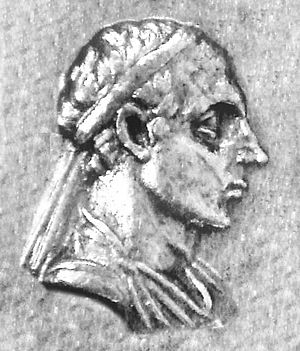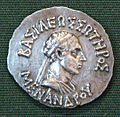Menander I facts for kids
Quick facts for kids Menander I |
|
|---|---|

Portrait of Menander I
|
|
| Indo-Greek king | |
| Reign | 165/155–130 BC |
| Predecessor | Antimachus II |
| Successor | Strato I |
| Born | Kalasi, Alexandria of the Caucasus (present day Bagram, Afghanistan) |
| Died | 130 BC |
| Burial | Stupas across the Indo-Greek Kingdom |
| Consort | Agathokleia |
| Issue | Strato I |
| House | House of Euthydemus |
| Religion | Buddhism |
Menander I Soter (also known as Milinda in ancient Indian texts) was a powerful Indo-Greek king. He ruled a large kingdom in the northwestern part of the Indian Subcontinent from about 165 BC to 130 BC. His capital city was Sagala.
Menander is famous for supporting Buddhism. He became a great friend and protector of this religion.
Menander's Kingdom
Menander started as a king in Bactria, an ancient kingdom. He then conquered the Punjab area. This helped him build a huge empire in the Indian Subcontinent.
His kingdom stretched from the Kabul River valley in the west to the Ravi River in the east. It also went from the Swat River valley in the north to Arachosia in the south.
Ancient Indian writers say he explored south into Rajasthan. He also went as far east as Pataliputra along the Ganges River Valley. A Greek geographer named Strabo wrote that Menander "conquered more tribes than Alexander the Great."
Coins and Influence
Many of Menander’s coins have been found. These coins show that his kingdom had a lot of trade and lasted a long time. They also tell us about his power and influence.
Menander was a strong supporter of Buddhism. He had many talks with a wise Buddhist teacher named Nagasena. These conversations are written down in an important Buddhist book called the Milinda Panha. The word panha means "question" in the Pali language.
Later Life and Death
Menander died in 130 BC. After his death, his wife Agathokleia became queen. She ruled as a regent for their young son, Strato I.
Buddhist stories say that Menander gave his kingdom to his son. Then, he left his royal life to focus on spiritual matters. However, another ancient writer, Plutarch, tells a different story. He says Menander died while fighting in a military campaign.
Plutarch also wrote that Menander's body was divided. Each part was given to different cities. These cities then placed his remains in special monuments. These monuments were likely stupas, which are dome-shaped Buddhist shrines.
Images for kids
-
Silver coin of Menander from the British Museum.
-
Silver coin of Menander, with the goddess Athena on the back. From the British Museum.
-
Vitarka Mudra hand gestures on Indo-Greek coins.
-
One of the first known pictures of the Buddha, from Gandhara.
See also
 In Spanish: Menandro I para niños
In Spanish: Menandro I para niños


















